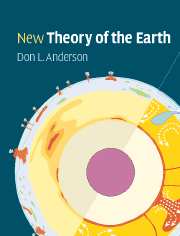Book contents
- Frontmatter
- Contents
- Preface and Philosophy
- Abbreviations and acronyms
- Part I Planetary perspective
- Part II Earth: the dynamic planet
- Part III Radial and lateral structure
- Part IV Sampling the Earth
- Part V Mineral physics
- Part VI Origin and evolution of the layers and blobs
- Part VII Energetics
- References and notes
- Appendix
- Index
Part II - Earth: the dynamic planet
Published online by Cambridge University Press: 05 June 2012
- Frontmatter
- Contents
- Preface and Philosophy
- Abbreviations and acronyms
- Part I Planetary perspective
- Part II Earth: the dynamic planet
- Part III Radial and lateral structure
- Part IV Sampling the Earth
- Part V Mineral physics
- Part VI Origin and evolution of the layers and blobs
- Part VII Energetics
- References and notes
- Appendix
- Index
Summary
This is the fourth time that I have taken part in a public discussion of this theory. In each previous one a distinguished biologist or geologist has presented the case for drift, and has been followed by equally distinguished ones who have pointed out facts that it would render more difficult to explain … The present impasse suggests that some important factor has been overlooked.
Sir Harold Jeffreys,1951Overview
Plate tectonics on Earth, at present, consists of about a dozen large semi-coherent entities – called plates – of irregular shape and size that move over the surface, separated by boundaries that meet at triple junctions. There are also many broad zones of deformation.
Plate tectonics is often regarded as simply the surface, or the most important, manifestation of thermal convection in the mantle [this phrase, and phrases in the same typeface, is a Googlet; see Preface or type it into a search engine]. In this view the plates are driven by thermal and density variations in the mantle. Cooling plates and sinking slabs can also be regarded as driving themselves, and driving convection in the underlying mantle; they create chemical, thermal and density anomalies in the mantle.
Plate tectonics qualifies as a branch of complexity theory. Plate tectonics may be a far-from-equilibrium self-organized system powered by heat and gravity from the mantle and organized by dissipation in and between the plates. Mantle convection, below the plates, may not drive or organize the plates; it may be the other way around.
- Type
- Chapter
- Information
- New Theory of the Earth , pp. 33 - 34Publisher: Cambridge University PressPrint publication year: 2007



